Overview
The article outlines essential strategies for re-electing union leaders in 2024, underscoring the significance of:
- Voter engagement
- Economic stability
- Party unity
- Effective communication
To capture attention, it is crucial to leverage technology, such as secure online voting platforms, which can significantly enhance voter turnout. Furthermore, addressing budget concerns and fostering cohesion within the union are vital components that will contribute to securing re-election in a competitive political landscape.
Union leadership must recognize the challenges they face and take proactive measures to build interest among voters. By implementing effective communication strategies and emphasizing economic stability, leaders can generate a desire for solutions that resonate with their constituents. This approach not only strengthens party unity but also cultivates a sense of shared purpose within the union.
In addition, it is imperative to utilize statistics and case studies that demonstrate the positive impact of these strategies. Engaging voters through testimonials and reflective questions can further enhance participation and commitment. Ultimately, the combination of these elements will prompt action among union leadership, ensuring a successful re-election campaign.
Introduction
The landscape of union leadership is on the brink of transformation as the 2024 elections draw near. Various strategies are emerging to bolster the re-election prospects of union leaders. This article explores seven pivotal tactics that not only address the pressing concerns of union members but also leverage technological advancements, economic insights, and social dynamics to cultivate a more engaged electorate.
As challenges mount—from budget deficits to the pervasive influence of social media—how can union leaders adeptly navigate these complexities to secure their positions? The exploration of these strategies will reveal the keys to successful campaigns in a rapidly evolving political environment.
Votem: Enhancing Voter Engagement Through Secure Online Voting
Votem’s CastIron platform revolutionizes voter engagement by providing a secure and compliant online voting solution tailored for organizations. By enabling members to cast their votes from any location at any time, the platform effectively addresses the accessibility challenges often associated with traditional voting methods. This flexibility is crucial for enhancing participation in labor elections, particularly in today’s mobile-first environment. Votem’s mobile-first user experience can elevate turnout by as much as three times on launch day, demonstrating its potential impact.
Furthermore, the platform’s robust encryption and unchangeable audit trail significantly enhance public trust, ensuring that every vote is accurately and securely counted. With over 13 million votes successfully managed, Votem showcases its . These features not only simplify the voting process but also cultivate a more engaged and participatory electorate.
In conclusion, Votem’s innovative approach to online voting not only addresses critical accessibility issues but also fosters a sense of confidence among voters. Union leadership should consider leveraging this platform to enhance voter engagement and participation in the process of re-electing candidates in upcoming elections.

Economic Stability: How Budget Deficits Affect Reelection Prospects
Budget deficits can significantly undermine voter trust and satisfaction, jeopardizing the re-electing prospects of organizational leaders. In times of economic uncertainty, union supporters often gravitate toward candidates who demonstrate a commitment to fiscal responsibility and economic growth. Recent polling reveals that 57% of Americans prioritize reducing the budget deficit, underscoring an escalating concern regarding financial management that has surged by 12 points since 2022.
Consequently, union representatives must proactively articulate their strategies for financial stewardship, detailing how they plan to safeguard the interests of their members during challenging economic climates. For example, Votem’s initiative to enhance public trust through secure online voting exemplifies effective communication in difficult circumstances.
By addressing these concerns adeptly, leaders can enhance their appeal and bolster their chances of re-electing in 2025. The economy stands as the preeminent factor influencing voter choices, making it imperative for representatives to align their messaging with the of those they serve.
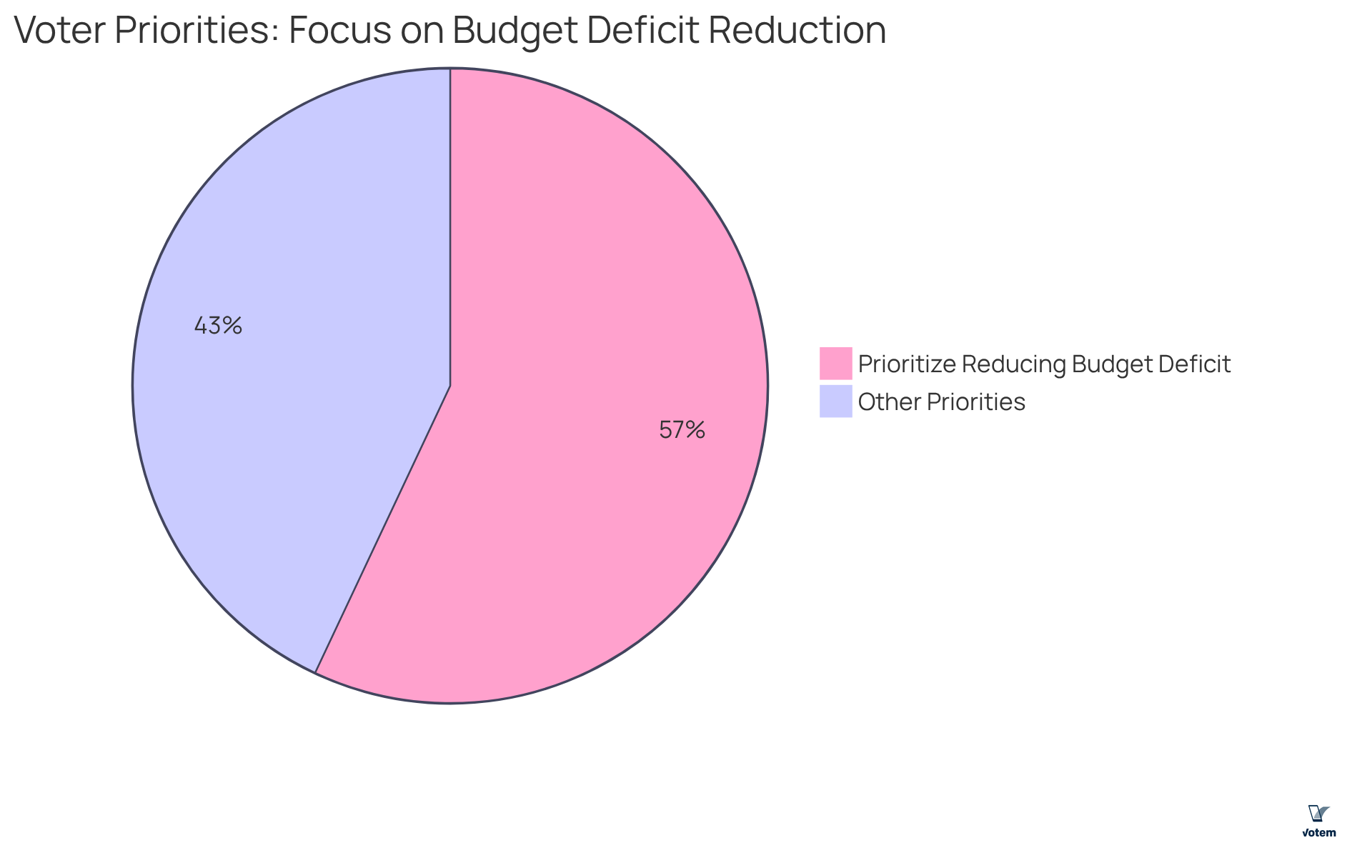
Party Unity: The Importance of Cohesion in Reelection Campaigns
Cohesion within the organization is paramount for successfully re-electing candidates during campaigns. When representatives demonstrate a , it not only enhances their credibility but also strengthens their trustworthiness among participants. However, unions often face challenges such as divergent priorities among individuals and external pressures that can threaten this unity. To foster collaboration, leaders must proactively address internal conflicts that may arise, as these can significantly influence election outcomes.
Regular communication is essential; it ensures that all voices are heard and valued, promoting an inclusive decision-making process. Active involvement is crucial; encouraging participation in meetings, rallies, and social events can enhance unity and build rapport among participants. For instance, the APWU underscores the significance of participant involvement in collective activities, which has proven effective in preserving cohesion. By prioritizing these collaborative efforts and addressing the challenges encountered, representatives can establish a robust foundation for their re-electing campaigns, ultimately leading to increased participant engagement and support.
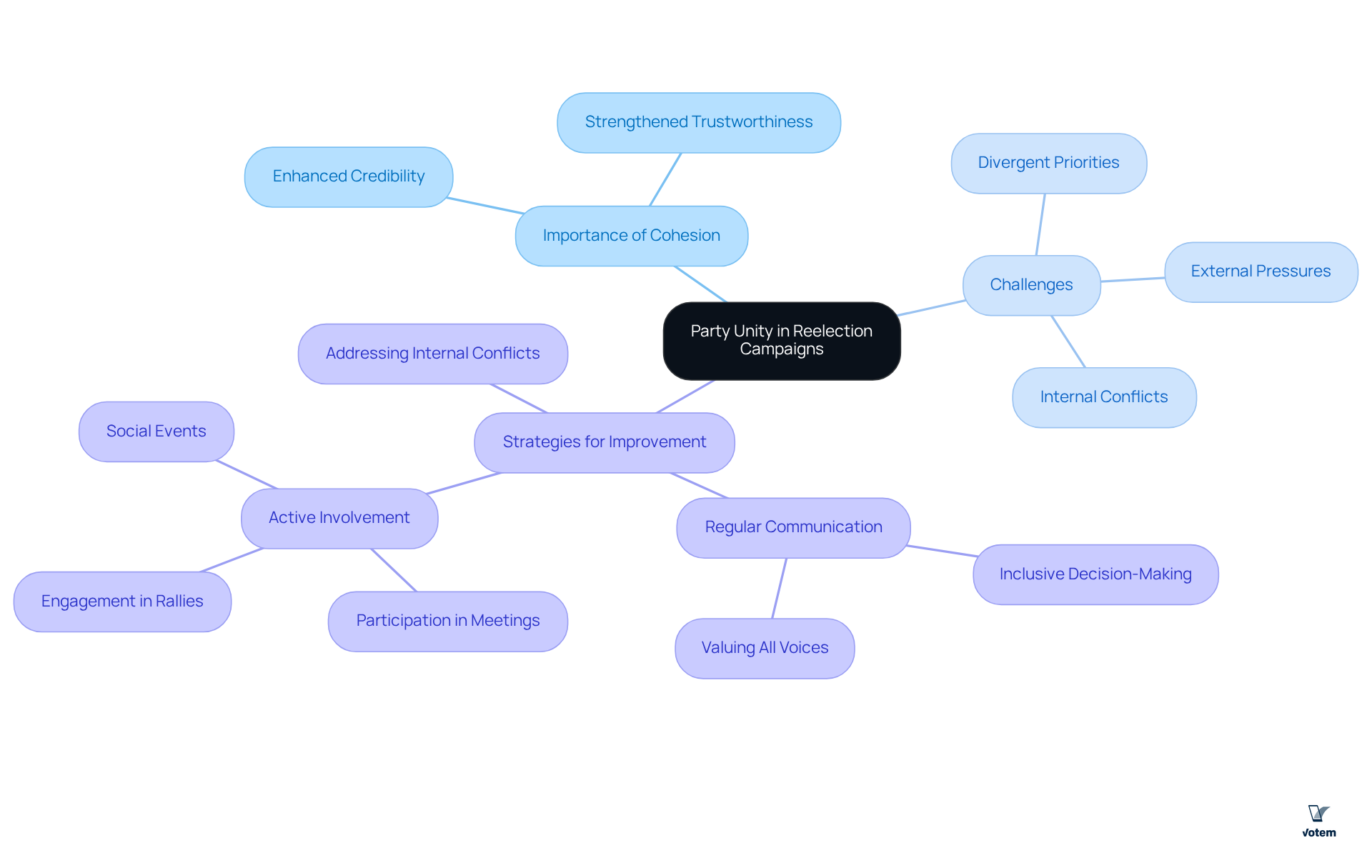
Voter Turnout: Strategies to Mobilize Electorate in 2024
To increase participation in the 2024 elections, union leaders must adopt targeted outreach strategies. Arranging informational sessions and utilizing social media campaigns can effectively involve participants, particularly younger individuals who are more engaged on digital platforms. Furthermore, providing resources that simplify the voting process is crucial, as many potential voters may face barriers such as lack of transportation—a significant reason for low turnout among young voters in previous elections. By ensuring that all participants comprehend the significance of their vote, organizations can significantly boost participation rates.
Significantly, using Votem’s online voting platform can simplify access to ballots, making it easier for participants to cast their votes from any location, thereby enhancing overall engagement. As April Verrett, President of SEIU, stated, ‘In an election this close, it’s all going to come down to turnout.’ This underscores the importance of efficiently engaging organization participants to achieve positive results. Lee Saunders, President of AFSCME, adds, ‘Union members are mobilizing with a new level of energy, because we know what’s at stake.’ With Votem’s mobile-first user experience, which can on launch day, labor organizations can tackle obstacles and improve engagement, especially in crucial states where households affiliated with labor groups represented significant portions of the votes cast.
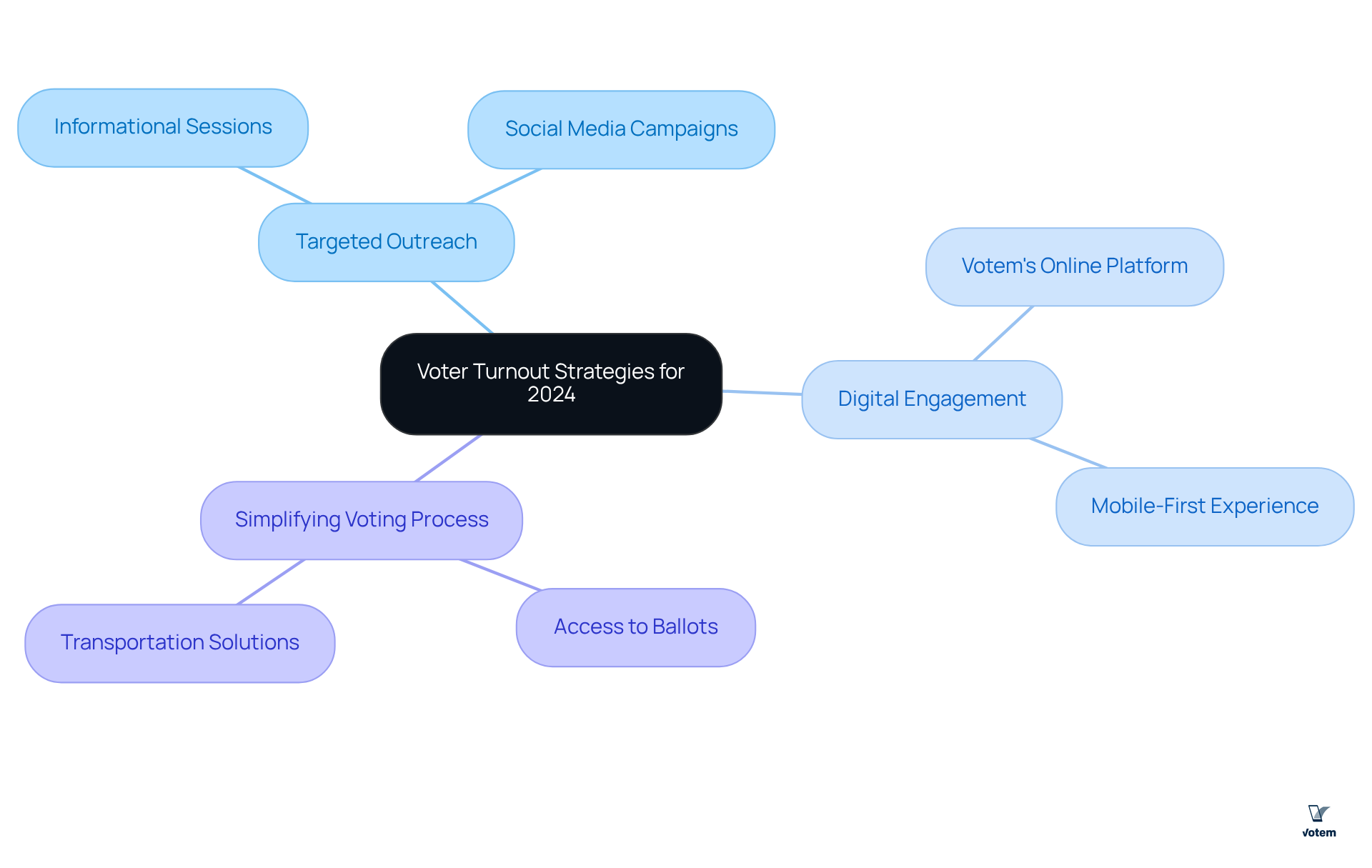
Social Media Influence: Shaping Public Opinion in the 2024 Elections
Social media platforms are pivotal in and mobilizing voters, making them indispensable tools for labor representatives. By actively engaging with members on platforms such as Facebook, Twitter, and Instagram, representatives can effectively share their vision, showcase achievements, and outline future plans. Producing shareable content that resonates with their audience not only enhances their messages but also fosters meaningful discussions about the significance of voting. Notably, nearly a third of individuals under 30 consistently turn to TikTok for news, underscoring the necessity for organizational leaders to prioritize social media engagement.
Moreover, addressing misinformation is critical; disseminating accurate information about the electoral process is essential for maintaining trust among constituents. Given that misinformation can significantly undermine electoral confidence, representatives must emphasize transparency and clarity in their communications to ensure that individuals remain well-informed and engaged. Additionally, implementing digital literacy programs can empower members to critically assess online information, while effective content moderation on social media platforms is vital for combating misinformation and sustaining trust.
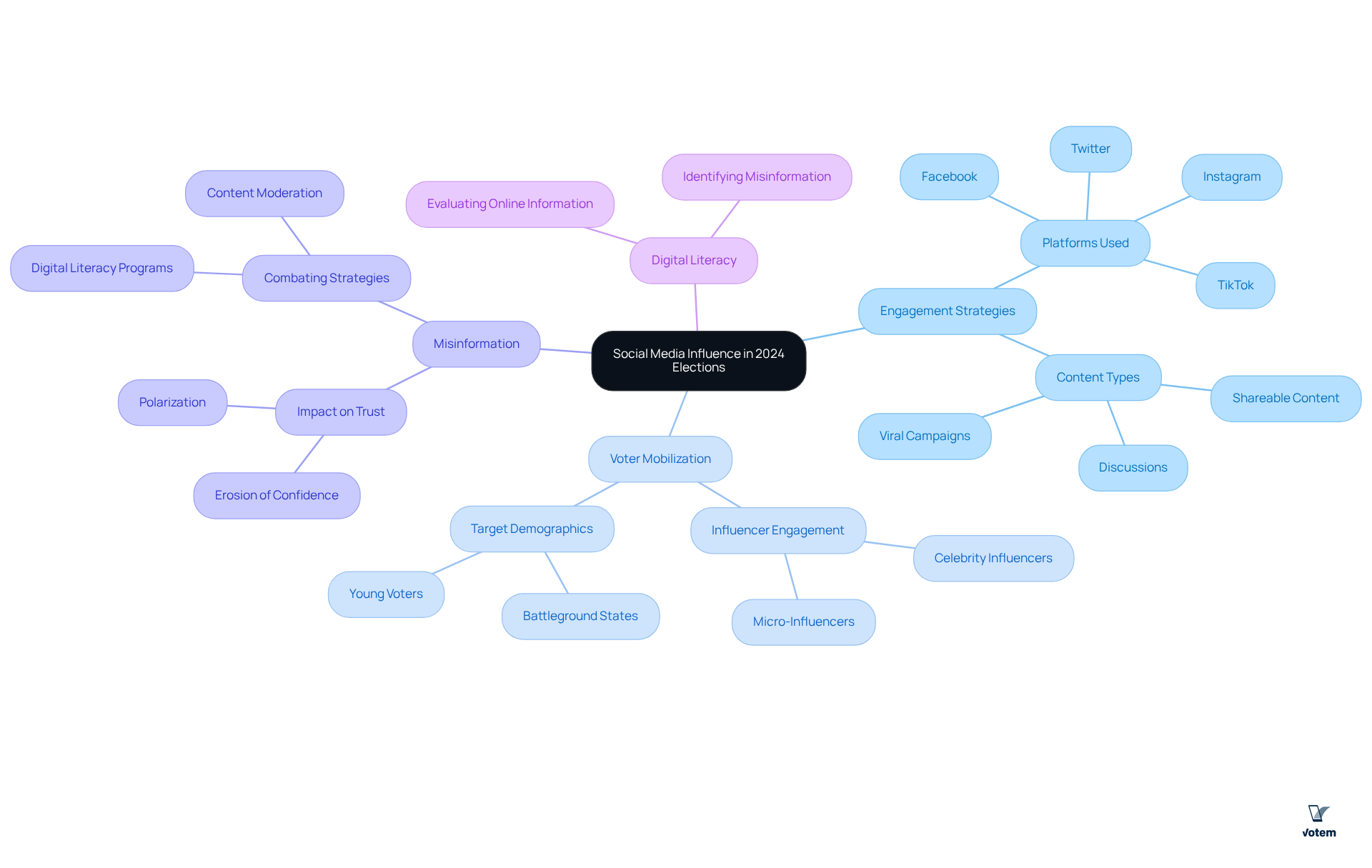
Incumbency Advantage: Leveraging Experience for Reelection Success
Current union representatives must strategically leverage their experience and established relationships to bolster their candidacy. By underscoring past accomplishments—such as successful negotiations and community involvement—individuals can cultivate trust and confidence among voters. For instance, the United Auto Workers (UAW) has actively engaged in initiatives that showcase their historical achievements, resonating with those concerned about job security and working conditions. Notably, UAW participation has plummeted from 1.5 million in the 1970s to just 380,000 today, underscoring the challenges representatives face in maintaining trust among members.
Leaders must also confront current challenges head-on, articulating their plans for the future and demonstrating how their experience uniquely equips them to lead effectively. This approach not only enhances voter confidence but also aligns with the growing trend of rank-and-file members seeking leaders who are responsive to their needs. The recent hurdles faced by the UFT, including the fact that it has not endorsed a successful mayoral candidate since 1989, illustrate how emphasizing a proven track record can be crucial in sustaining support amid opposition.
Moreover, with 44% of labor members supporting Trump, it is imperative for representatives to adeptly navigate prevailing political sentiments. Ultimately, a well-crafted narrative that can significantly elevate a candidate’s re-electing campaign. Additionally, harnessing technology—such as Votem’s capabilities, which have effectively managed over 13 million votes and feature a mobile-first user experience that can increase turnout by up to three times on launch day—can further enhance election strategies.
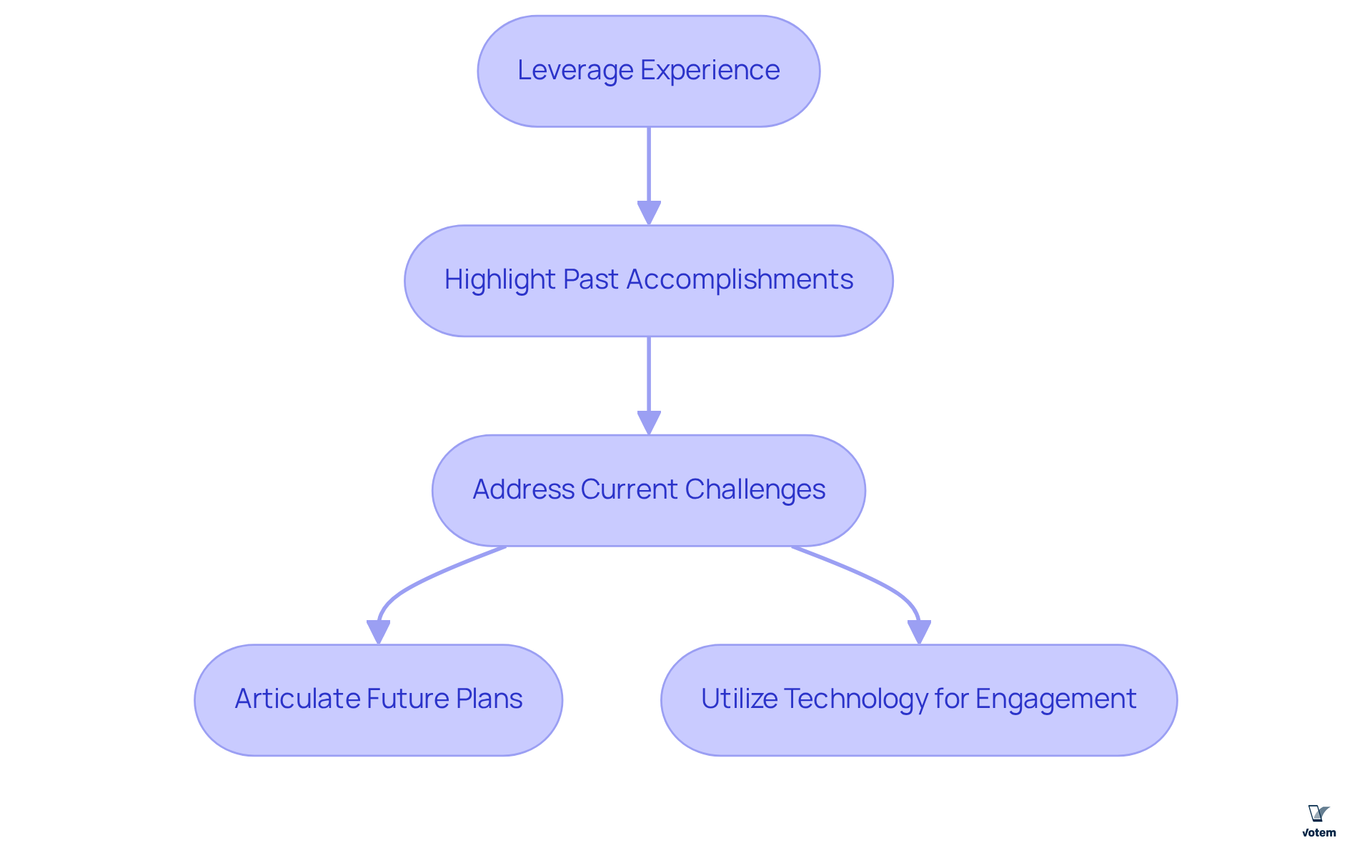
Demographic Changes: Analyzing Shifts in Voter Preferences
Demographic changes significantly shape voter preferences and turnout within unions. Union leaders must examine shifts in their to adapt their messaging effectively. This involves recognizing the unique issues and priorities of diverse groups, including younger individuals, women, and minority populations. Notably, the 2024 election saw a substantial increase in support for Democratic candidates among labor organization affiliates, which is crucial for re-electing them, as their vote share exceeded that of non-affiliates by 10 percentage points. Furthermore, internal surveys among United Auto Workers participants in swing states revealed a 22-point preference for re-electing Harris over Trump.
To enhance engagement and strengthen support for organizational leadership, outreach efforts must be tailored to meet the specific needs of these varied groups. For instance, educational campaigns focusing on economic policies have effectively informed members about the pro-worker successes of the Biden-Harris administration, leading to increased voter turnout, which rose from 9 percent in 2020 to 11 percent in 2024, contributing to a strong case for re-electing them. By understanding and addressing the distinct dynamics within their membership, representatives can foster a more inclusive atmosphere that resonates with all members, ultimately enhancing their electoral success.
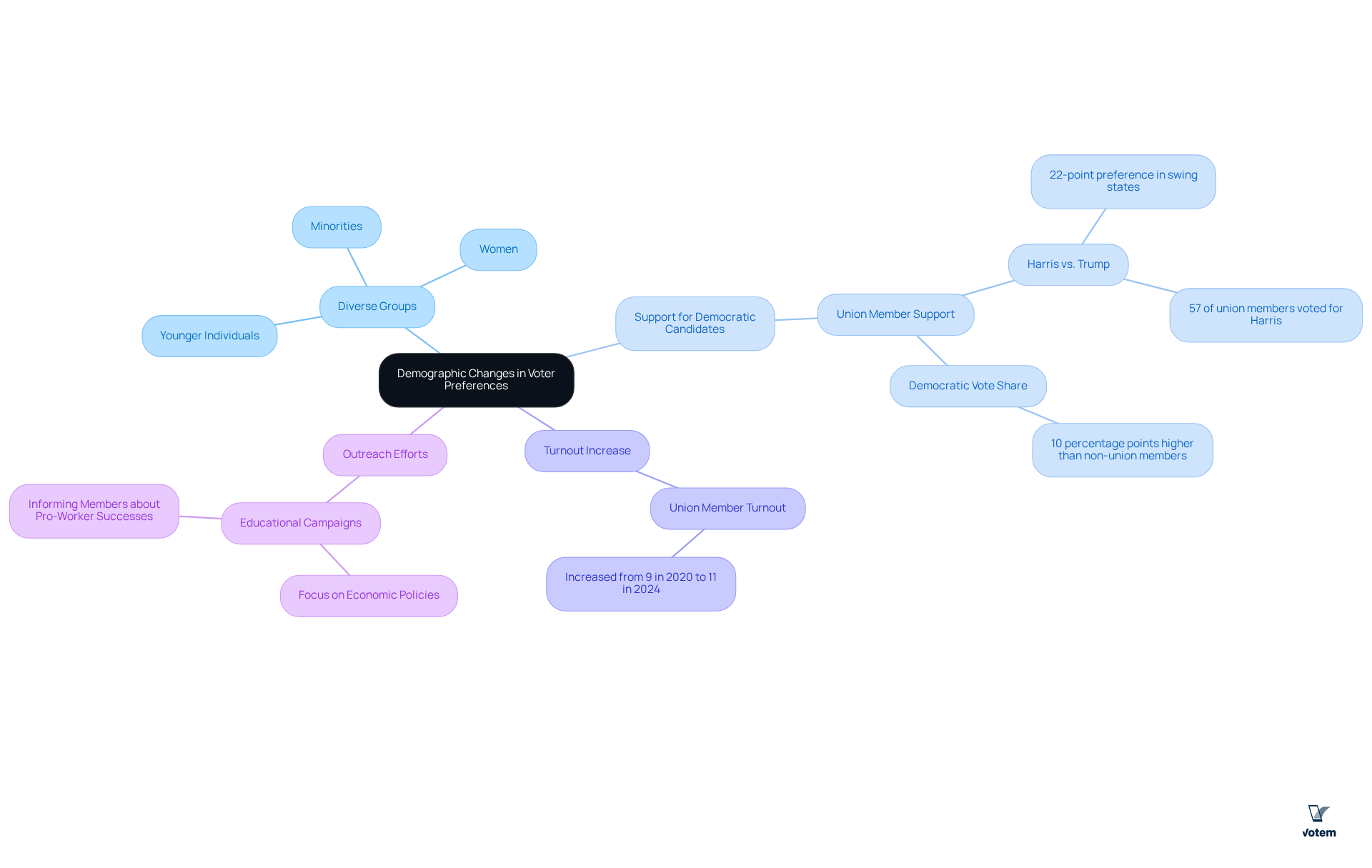
Campaign Financing: The Financial Backbone of Reelection Efforts
Campaign financing is pivotal to the success of re-electing union leaders. A comprehensive fundraising approach should encompass:
- Direct outreach to individuals for contributions
- Engaging fundraising events
- Endorsements from influential allies
For instance, the Democratic National Committee recently reported an impressive $8.6 million in grassroots donations for June 2025, showcasing the potential of mobilizing supporter backing. Furthermore, the DNC has collected over $50 million since the beginning of 2025, demonstrating the magnitude of effective fundraising activities that can motivate labor representatives.
Openness in financial transactions is equally important; it nurtures trust among participants, ensuring they feel assured about how their contributions are utilized to strengthen the campaign. By prioritizing clear communication regarding fundraising initiatives and spending, organization heads can enhance participant engagement and backing. Votem’s commitment to , including the publication of an immutable audit trail, reinforces the importance of trust in financial dealings.
Additionally, successful fundraising events, such as the 138 town halls hosted by DNC Chair Ken Martin, can significantly impact election outcomes by rallying support and increasing visibility. As observed in recent campaigns, effective fundraising strategies not only secure necessary resources but also motivate participant involvement, ultimately strengthening the union’s position in the electoral landscape for re-electing candidates.

Leadership Perception: Evaluating Effectiveness in the Eyes of Voters
Voter perceptions of are pivotal for re-electing candidates successfully. Union representatives must proactively seek input from participants to understand their perspectives and identify areas for improvement. As Shawn Fain, UAW president, emphasizes, “When individuals hear directly from other individuals about what’s at stake and which candidate will support them, we’re able to break through.” Demonstrating accountability, transparency, and responsiveness to concerns can significantly enhance their image as effective leaders, which is crucial for re-electing them.
Additionally, showcasing testimonials from participants regarding the positive impact of their leadership can bolster their candidacy for re-electing them. Notably, statistics reveal that 57 percent of workers supported Harris in 2024, underscoring the critical role of strong leadership and participant engagement.
To gather participant feedback effectively, organization representatives can employ strategies such as:
- Surveys
- Focus groups
- Ongoing communication channels
These approaches can directly influence management effectiveness and election outcomes.
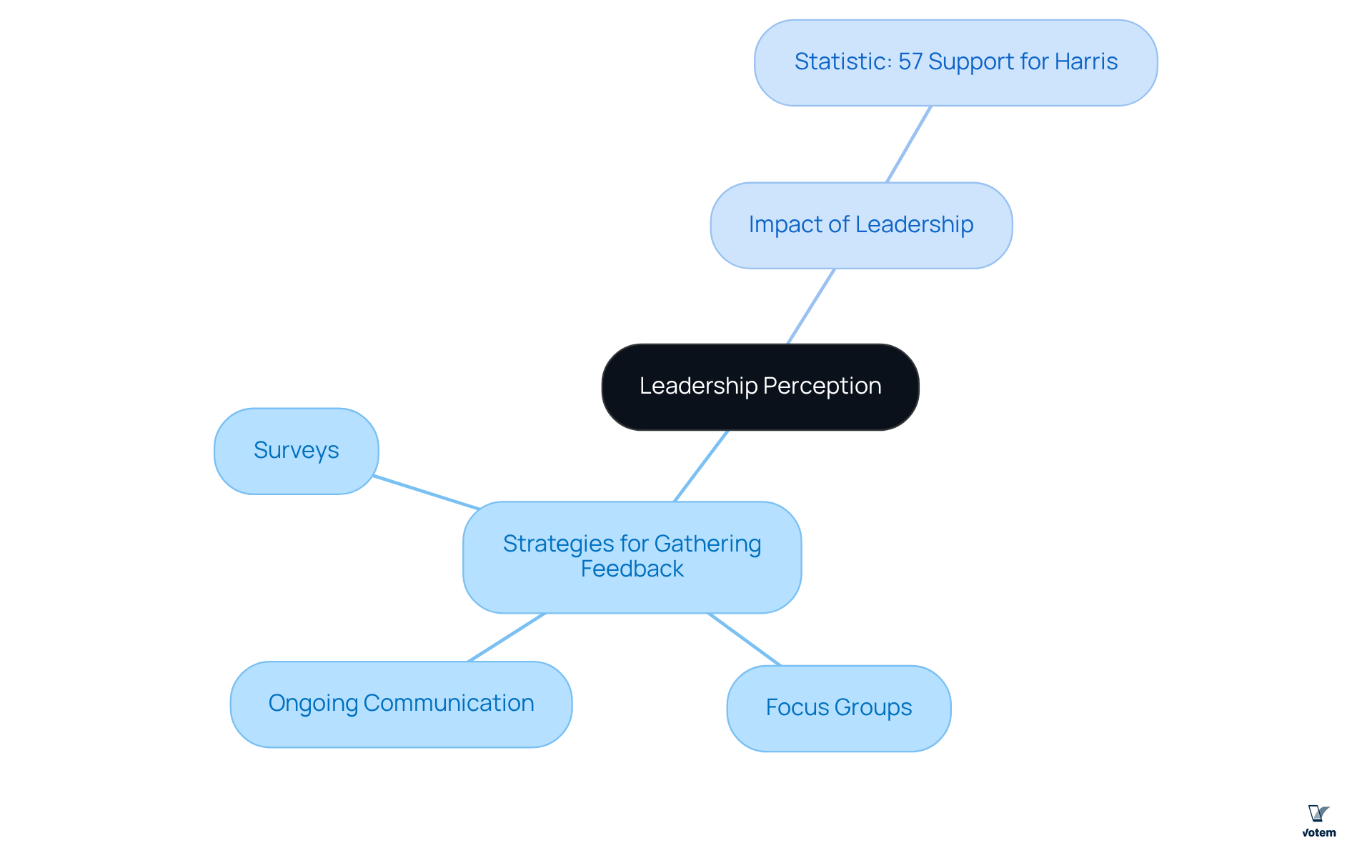
External Events: How Crises Shape Reelection Dynamics
External events, such as economic crises, social movements, and significant political changes, can dramatically shape the dynamics of re-electing candidates in campaigns. Union leaders must remain vigilant and responsive to these developments. By adjusting their strategies to address constituents’ concerns, they can seize opportunities for engagement. Proactively communicating how the union intends to navigate these challenges not only reinforces trust but also strengthens support among members, ultimately influencing their voting behavior.
Furthermore, understanding the implications of these external factors is crucial for effective leadership. Union leaders should analyze how such events and the broader community. This analysis can lead to informed strategies that resonate with constituents, fostering a sense of solidarity and shared purpose.
In addition, by highlighting the union’s proactive measures in response to these challenges, leaders can cultivate a narrative of resilience and adaptability. This narrative serves to inspire confidence among members, encouraging them to participate actively in the electoral process.
Ultimately, the ability to navigate external events effectively will not only enhance the union’s credibility but also empower members to make informed decisions at the polls, particularly when it comes to re-electing candidates. Union leaders are called to action: stay informed, engage with your constituents, and lead with confidence.
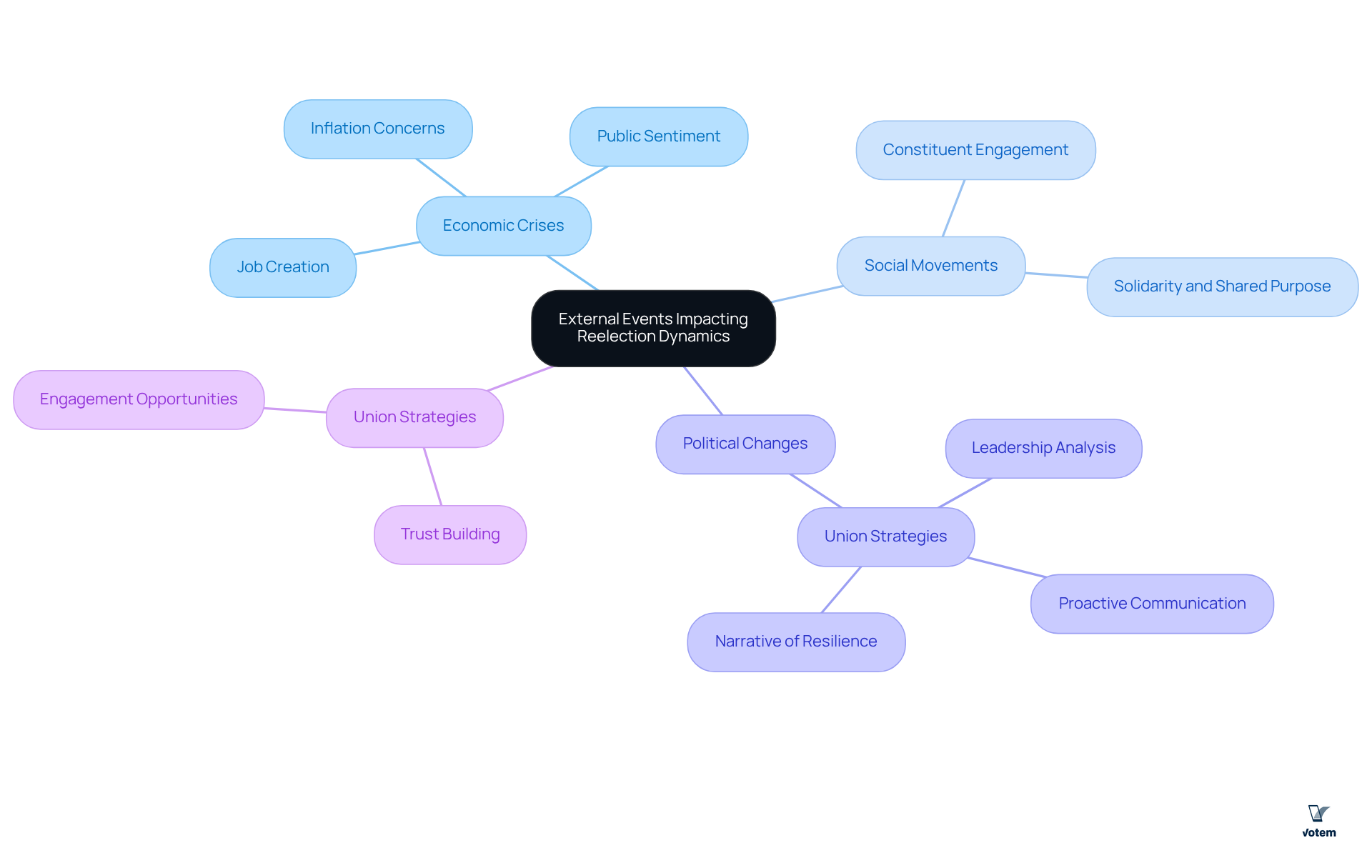
Conclusion
The strategies for re-electing union leaders in 2024 encompass a multifaceted approach that prioritizes voter engagement, economic stability, party unity, and effective communication. By leveraging innovative solutions like secure online voting platforms, union representatives can enhance participation and trust among their members. Understanding the critical importance of addressing economic concerns and demonstrating fiscal responsibility is essential for building voter confidence and support.
Key insights from the article highlight the necessity of cohesive campaigns that actively involve members, utilize social media to shape public opinion, and adapt to demographic shifts. Furthermore, effective campaign financing and a strong emphasis on leadership perception can significantly influence electoral outcomes. By recognizing the impact of external events and crises, union leaders can navigate challenges while reinforcing their commitment to their constituents.
Ultimately, the success of union leaders in the upcoming elections hinges on their ability to engage with their members authentically and responsively. Embracing technology, fostering unity, and maintaining transparency will not only enhance voter turnout but also solidify the trust and support necessary for re-election. As the 2024 elections approach, union representatives are encouraged to adopt these strategies and remain vigilant in their efforts to connect with their electorate, ensuring their voices are heard and valued in the democratic process.
Frequently Asked Questions
What is Votem’s CastIron platform?
Votem’s CastIron platform is a secure and compliant online voting solution designed to enhance voter engagement by allowing members to cast their votes from any location at any time, addressing accessibility challenges associated with traditional voting methods.
How does Votem improve voter participation?
Votem improves voter participation by providing a mobile-first user experience that can elevate turnout by as much as three times on launch day, making it easier for voters to engage in the election process.
What security features does Votem offer?
Votem offers robust encryption and an unchangeable audit trail, which significantly enhance public trust by ensuring that every vote is accurately and securely counted.
How many votes has Votem managed successfully?
Votem has successfully managed over 13 million votes, showcasing its reliability and efficiency in handling large volumes of ballots.
Why are budget deficits important in the context of reelection prospects?
Budget deficits can undermine voter trust and satisfaction, making it crucial for organizational leaders to demonstrate fiscal responsibility and articulate their financial stewardship strategies to enhance their reelection prospects.
What do recent polls indicate about American voters’ priorities regarding budget deficits?
Recent polling reveals that 57% of Americans prioritize reducing the budget deficit, highlighting an increasing concern about financial management that has risen by 12 points since 2022.
How can union representatives improve their chances of reelection in 2025?
Union representatives can improve their chances of reelection by effectively communicating their strategies for financial stewardship and aligning their messaging with the financial interests of their members.
What role does cohesion play in reelection campaigns?
Cohesion within the organization is crucial for successfully re-electing candidates, as a unified stance enhances credibility and trustworthiness among participants.
What challenges do unions face in maintaining cohesion?
Unions often face challenges such as divergent priorities among individuals and external pressures that can threaten unity, which must be addressed to influence election outcomes positively.
How can leaders foster collaboration among union members?
Leaders can foster collaboration by ensuring regular communication, promoting an inclusive decision-making process, and encouraging active participation in meetings, rallies, and social events to build rapport and unity among participants.
List of Sources
- Votem: Enhancing Voter Engagement Through Secure Online Voting
- Pete Martin Wants to Restore Faith in Elections with New Voting Technologies (https://finance.yahoo.com/news/pete-martin-wants-restore-faith-151500586.html)
- Easy to Vote and Nearly Impossible to Cheat | Online Voting with Votem® (https://votem.com/easy-to-vote-and-nearly-impossible-to-cheat)
- Voting Equipment Database – Votem CastIron Voting Platform (https://verifiedvoting.org/election-system/votem-castiron)
- Votem Corp. buys California web-based voting business Everyone Counts (https://crainscleveland.com/technology/votem-corp-buys-california-web-based-voting-business-everyone-counts)
- Economic Stability: How Budget Deficits Affect Reelection Prospects
- Deficit Worries Making a Return as a 2024 Political Issue (https://bloomberg.com/news/newsletters/2023-10-24/deficit-worries-making-a-return-as-a-2024-political-issue)
- Biden budget with deficit cuts, tax hikes won’t fly with GOP (https://thenationaldesk.com/news/americas-news-now/biden-budget-with-deficit-cuts-tax-hikes-wont-fly-with-gop-president-fiscal-year-2024-republicans-democrats-americans-finances-state-of-the-union-economy-inflation-congress)
- Economy Most Important Issue to 2024 Presidential Vote (https://news.gallup.com/poll/651719/economy-important-issue-2024-presidential-vote.aspx)
- 6 facts about Americans’ views of government spending and the deficit (https://pewresearch.org/short-reads/2023/05/24/6-facts-about-americans-views-of-government-spending-and-the-deficit)
- Party Unity: The Importance of Cohesion in Reelection Campaigns
- Unity is Key to Our Continuing Progress | American Postal Workers Union (https://apwu.org/news/unity-key-our-continuing-progress)
- Keeping a Union Strong and Cohesive | Unions United (https://jamspathways.com/news-insights/unions-united-how-to-keep-your-union-strong-and-cohesive)
- Service Employees International Union (SEIU) (https://seiu.org/2024/03/workers-ready-to-make-decisive-impact-in-2024-elections)
- US union organizing, and unions’ election win rate, is surging, NLRB says (https://reuters.com/legal/litigation/us-union-organizing-unions-election-win-rate-is-surging-nlrb-says-2024-07-17)
- Voter Turnout: Strategies to Mobilize Electorate in 2024
- Mobilize Voters: How Unions Can Influence the 2020 Elections (https://uniontrack.com/blog/unions-mobilize-voters)
- Largest Public Sector Labor Unions Unite to Get Out the Vote in Battleground States (https://afscme.org/press/releases/2024/largest-public-sector-labor-unions-unite-to-get-out-the-vote-in-battleground-states)
- Voter Turnout Database | International IDEA (https://idea.int/data-tools/data/voter-turnout-database)
- Service Employees International Union (SEIU) (https://seiu.org/2024/03/workers-ready-to-make-decisive-impact-in-2024-elections)
- Social Media Influence: Shaping Public Opinion in the 2024 Elections
- Social Media’s Influence on Election (https://therideronline.com/top-story/2024/10/social-medias-influence-on-the-election)
- pbs.org (https://pbs.org/newshour/show/how-social-media-influencers-are-playing-a-role-in-the-presidential-election)
- How disinformation defined the 2024 election narrative | Brookings (https://brookings.edu/articles/how-disinformation-defined-the-2024-election-narrative)
- How Media – Namely News, Ads and Social Posts – Can Shape an Election (https://rutgers.edu/news/how-media-namely-news-ads-and-social-posts-can-shape-election)
- Incumbency Advantage: Leveraging Experience for Reelection Success
- First Thing: Boost for Biden as United Auto Workers union endorses his re-election (https://theguardian.com/us-news/2024/jan/25/first-thing-boost-for-biden-as-united-auto-workers-union-endorses-his-re-election)
- UAW faces setback in Trump’s victory, undermining efforts to rebuild political influence (https://cbtnews.com/uaw-faces-setback-in-trumps-victory-undermining-efforts-to-rebuild-political-influence)
- Biden is returning to his union roots as his 2024 campaign gears up (https://apnews.com/article/biden-unions-reelection-campaign-2024-04b89292c9c41f35a127f2458d90a610)
- Shawn Fain, president of the UAW: ‘Workers realized they’ve been getting screwed for decades’ (https://theguardian.com/us-news/2024/apr/13/shawn-fain-president-uaw-union-interview)
- Powerful teachers union head faces reelection test amid contentious mayoral primary (https://politico.com/news/2025/03/02/teachers-union-head-reelection-new-york-00206524)
- Demographic Changes: Analyzing Shifts in Voter Preferences
- See how demographic swings could impact the 2024 election (https://abcnews.go.com/538/demographic-swings-impact-2024-election/story?id=108700434)
- How the electorate has changed in key states and what it could mean this election (https://npr.org/2024/09/06/nx-s1-5101765/swing-states-demographics-electorate)
- Election 2024 Potential Impacts: Youth Voting Preferences | Events | Holland & Knight (https://hklaw.com/en/events/2024/10/election-2024-potential-impacts-youth-voting-preferences)
- Voter Demographics – Research and data from Pew Research Center (https://pewresearch.org/topic/politics-policy/us-elections-voters/voters-voting/voter-demographics)
- While Other Voters Moved Away From the Democrats, Union Members Shifted Toward Harris in 2024 (https://americanprogressaction.org/article/while-other-voters-moved-away-from-the-democrats-union-members-shifted-toward-harris-in-2024)
- Campaign Financing: The Financial Backbone of Reelection Efforts
- Top GOP campaign committees dominate Dems in 2025 fundraising (https://nypost.com/2025/07/21/us-news/top-gop-campaign-committees-dominate-dems-in-2025-fundraising)
- Understanding ways to support federal candidates – FEC.gov (https://fec.gov/introduction-campaign-finance/understanding-ways-support-federal-candidates)
- DNC touts ‘best-ever’ grassroots fundraising numbers for June (https://spectrumlocalnews.com/nys/hudson-valley/politics/2025/07/21/dnc-touts–best-ever–grassroots-fundraising-numbers-for-june-amid-internal-turmoil)
- California blesses political donors’ strategy to multiply their influence (https://calmatters.org/politics/2025/01/california-political-donors)
- Union leaders share strategies for thriving in red states (https://aft.org/news/union-leaders-share-strategies-thriving-red-states)
- Leadership Perception: Evaluating Effectiveness in the Eyes of Voters
- Union workers could decide this election — and their unions know it (https://npr.org/2024/10/29/nx-s1-5170308/labor-unions-election-harris-pennsylvania)
- npr.org (https://npr.org/2024/09/24/nx-s1-5118428-e1/union-voters-were-never-a-monolith-this-election-season-is-no-different)
- While Other Voters Moved Away From the Democrats, Union Members Shifted Toward Harris in 2024 (https://americanprogressaction.org/article/while-other-voters-moved-away-from-the-democrats-union-members-shifted-toward-harris-in-2024)
- pewresearch.org (https://pewresearch.org/short-reads/2024/10/17/key-facts-about-union-members-and-the-2024-election)
- External Events: How Crises Shape Reelection Dynamics
- AOC contradicts Biden, says economy in ‘crisis’ during union workers speech (https://foxnews.com/politics/aoc-contradicts-biden-says-economy-crisis-union-workers-speech)
- Unions poised to capitalize on U.S. labor board rulings that bolstered organizing (https://reuters.com/legal/government/unions-poised-capitalize-us-labor-board-rulings-that-bolstered-organizing-2024-01-02)
- What Trump’s reelection means for union workers, according to experts (https://abcnews.go.com/Business/trumps-reelection-means-union-workers-experts/story?id=115731176)
- Why the most pro-labor president ever is sweating the union vote (https://politico.com/newsletters/politico-nightly/2024/05/09/why-the-most-pro-labor-president-ever-is-sweating-the-union-vote-00157201)

